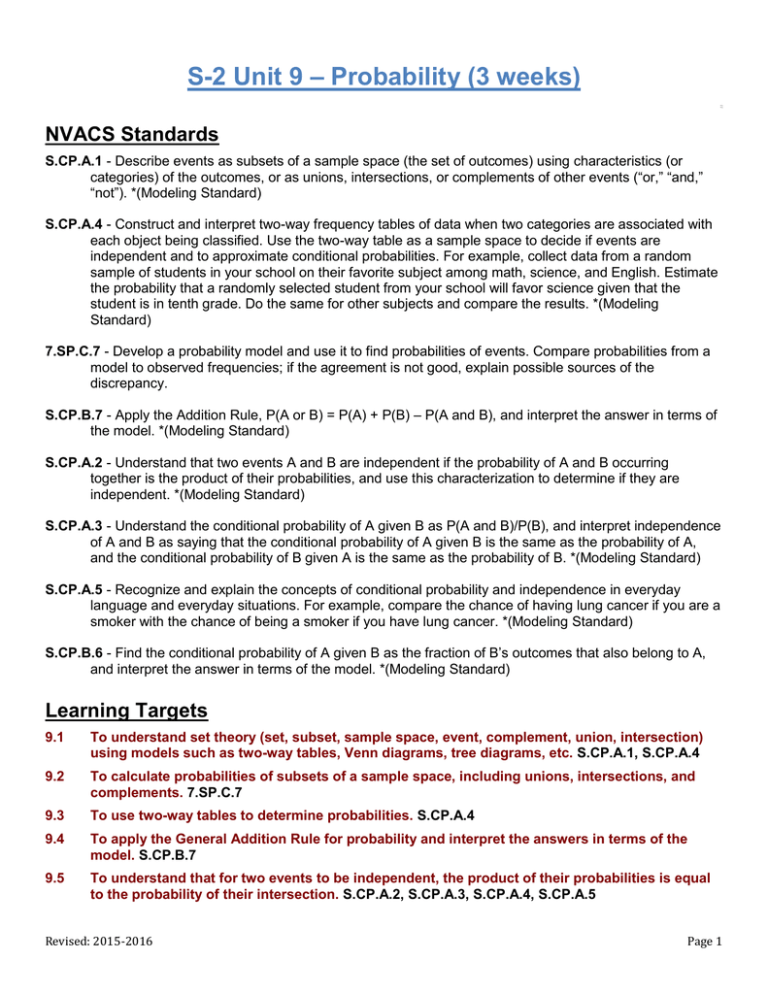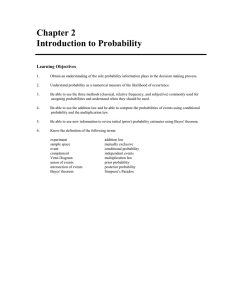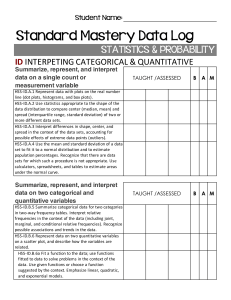– Probability (3 weeks) S-2 Unit 9 NVACS Standards
advertisement

S-2 Unit 9 – Probability (3 weeks) Drag Drag NVACS Standards S.CP.A.1 - Describe events as subsets of a sample space (the set of outcomes) using characteristics (or categories) of the outcomes, or as unions, intersections, or complements of other events (“or,” “and,” “not”). *(Modeling Standard) S.CP.A.4 - Construct and interpret two-way frequency tables of data when two categories are associated with each object being classified. Use the two-way table as a sample space to decide if events are independent and to approximate conditional probabilities. For example, collect data from a random sample of students in your school on their favorite subject among math, science, and English. Estimate the probability that a randomly selected student from your school will favor science given that the student is in tenth grade. Do the same for other subjects and compare the results. *(Modeling Standard) 7.SP.C.7 - Develop a probability model and use it to find probabilities of events. Compare probabilities from a model to observed frequencies; if the agreement is not good, explain possible sources of the discrepancy. S.CP.B.7 - Apply the Addition Rule, P(A or B) = P(A) + P(B) – P(A and B), and interpret the answer in terms of the model. *(Modeling Standard) S.CP.A.2 - Understand that two events A and B are independent if the probability of A and B occurring together is the product of their probabilities, and use this characterization to determine if they are independent. *(Modeling Standard) S.CP.A.3 - Understand the conditional probability of A given B as P(A and B)/P(B), and interpret independence of A and B as saying that the conditional probability of A given B is the same as the probability of A, and the conditional probability of B given A is the same as the probability of B. *(Modeling Standard) S.CP.A.5 - Recognize and explain the concepts of conditional probability and independence in everyday language and everyday situations. For example, compare the chance of having lung cancer if you are a smoker with the chance of being a smoker if you have lung cancer. *(Modeling Standard) S.CP.B.6 - Find the conditional probability of A given B as the fraction of B’s outcomes that also belong to A, and interpret the answer in terms of the model. *(Modeling Standard) Learning Targets 9.1 To understand set theory (set, subset, sample space, event, complement, union, intersection) using models such as two-way tables, Venn diagrams, tree diagrams, etc. S.CP.A.1, S.CP.A.4 9.2 To calculate probabilities of subsets of a sample space, including unions, intersections, and complements. 7.SP.C.7 9.3 To use two-way tables to determine probabilities. S.CP.A.4 9.4 To apply the General Addition Rule for probability and interpret the answers in terms of the model. S.CP.B.7 9.5 To understand that for two events to be independent, the product of their probabilities is equal to the probability of their intersection. S.CP.A.2, S.CP.A.3, S.CP.A.4, S.CP.A.5 Revised: 2015-2016 Page 1 9.6 To understand, calculate, and interpret the conditional probability of A given B as P(A|B) = P(A and B)/P(B) based on real-world situations. S.CP.A.3 9.7 To determine whether two events are independent using conditional probability in context of real-world situations. S.CP.A.5, S.CP.B.6 Revised: 2015-2016 Page 2






